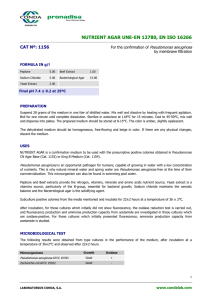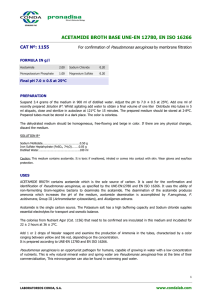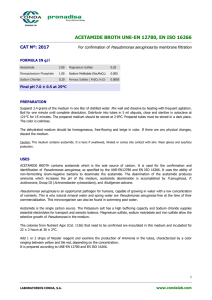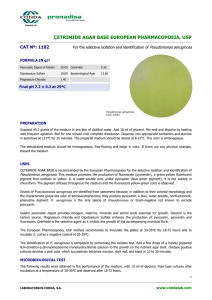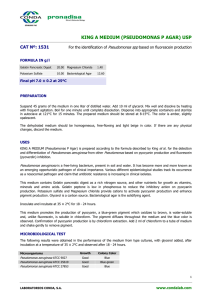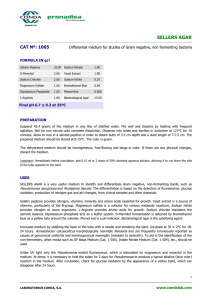ACETAMIDE AGAR CAT Nº: 1391 Pseudomonas aeruginosa
advertisement
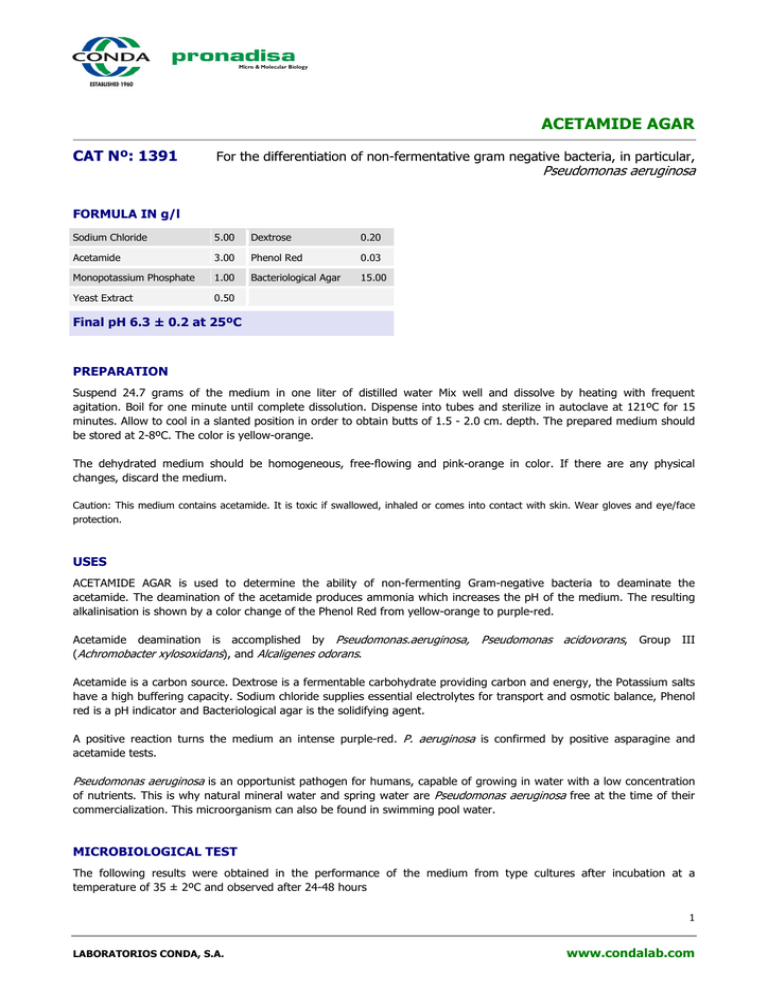
ACETAMIDE AGAR CAT Nº: 1391 For the differentiation of non-fermentative gram negative bacteria, in particular, Pseudomonas aeruginosa FORMULA IN g/l Sodium Chloride 5.00 Dextrose 0.20 Acetamide 3.00 Phenol Red 0.03 Monopotassium Phosphate 1.00 Bacteriological Agar 15.00 Yeast Extract 0.50 Final pH 6.3 ± 0.2 at 25ºC PREPARATION Suspend 24.7 grams of the medium in one liter of distilled water Mix well and dissolve by heating with frequent agitation. Boil for one minute until complete dissolution. Dispense into tubes and sterilize in autoclave at 121ºC for 15 minutes. Allow to cool in a slanted position in order to obtain butts of 1.5 - 2.0 cm. depth. The prepared medium should be stored at 2-8ºC. The color is yellow-orange. The dehydrated medium should be homogeneous, free-flowing and pink-orange in color. If there are any physical changes, discard the medium. Caution: This medium contains acetamide. It is toxic if swallowed, inhaled or comes into contact with skin. Wear gloves and eye/face protection. USES ACETAMIDE AGAR is used to determine the ability of non-fermenting Gram-negative bacteria to deaminate the acetamide. The deamination of the acetamide produces ammonia which increases the pH of the medium. The resulting alkalinisation is shown by a color change of the Phenol Red from yellow-orange to purple-red. Acetamide deamination is accomplished by Pseudomonas.aeruginosa, Pseudomonas acidovorans, Group (Achromobacter xylosoxidans), and Alcaligenes odorans. III Acetamide is a carbon source. Dextrose is a fermentable carbohydrate providing carbon and energy, the Potassium salts have a high buffering capacity. Sodium chloride supplies essential electrolytes for transport and osmotic balance, Phenol red is a pH indicator and Bacteriological agar is the solidifying agent. A positive reaction turns the medium an intense purple-red. P. aeruginosa is confirmed by positive asparagine and acetamide tests. Pseudomonas aeruginosa is an opportunist pathogen for humans, capable of growing in water with a low concentration of nutrients. This is why natural mineral water and spring water are Pseudomonas aeruginosa free at the time of their commercialization. This microorganism can also be found in swimming pool water. MICROBIOLOGICAL TEST The following results were obtained in the performance of the medium from type cultures after incubation at a temperature of 35 ± 2ºC and observed after 24-48 hours 1 LABORATORIOS CONDA, S.A. www.condalab.com Microorganisms Growth Purple - Red Escherichia coli ATCC 25922 Inhibited - Proteus mirabilis ATCC 29906 Inhibited - Pseudomonas aeruginosa ATCC 9027 Good + Pseudomonas aeruginosa ATCC 25668 Good + BIBLIOGRAPHY Gilardi. 1974. Antonie van Leewenhoek. J. Microbiol. Serol. 39:229. Buhlmann, Vischer and Bruhin. 1961. J. Bacteriol. 82:787. Clesceri, Greenberg and Eaton (ed.) 1998. Standard methods for the examination of water and wastewater, 20th ed. American Public Health Association, Washington, D.C. Murray, Baron, Pfaller, Tenover and Yolken (ed.). 1999. Manual of clinical microbiology, 7th ed. American Society for Microbiology, Washington, D.C STORAGE 25ºC Once opened keep powdered medium closed to avoid hydration. 2ºC 2 LABORATORIOS CONDA, S.A. www.condalab.com
